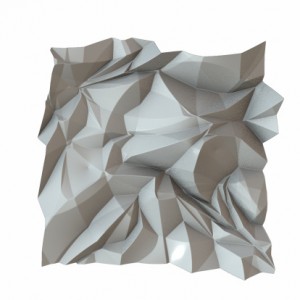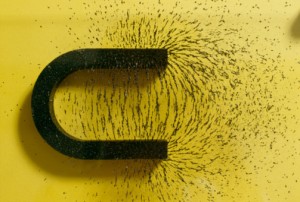Folds, Fractals and Holograms in Lurianic Kabbalah (Part 4)
By Asher Crispe: June 20, 2012: Category Inspirations, Networks of Meaning
Folds
Is the whole of reality folded up into each of its details? Is this not the Lurianic obsession with interinclusion? Does this not imply the framing of an infinitely large system comprised of finite phases of the greater whole? Revisiting Leibniz, we have to assume that the Great Chain of Being does not only hang down nor simply afford the opportunity to climb up, but rather curls in on itself until it loses all extension:
This interconnection or accommodation of all created things to each other, and each to all the others, brings it about that each simple substance has relations that express all the others, and consequently, that each simple substance is a perpetual, living mirror of the universe. (19)
 Not to suggest that Leibniz’s monad is identical with the Lurianic conception of interinclusion but that they represent similar strategies for arriving at a similar place. Not to imply that the “Lurianic conception” is a singular conception identical for all those editors and writers who claim their inspiration links directly back to him in the chain of tradition that they lay claim to. Yet, among the multiplicity of conceptions that may qualify as Lurianic, the structural emphasis on “complex systems theory” irrefutably contains a superabundance of folds where concepts wrap back on themselves and self-replicate in a seemingly endless role-play of ‘self as self in other’.
Not to suggest that Leibniz’s monad is identical with the Lurianic conception of interinclusion but that they represent similar strategies for arriving at a similar place. Not to imply that the “Lurianic conception” is a singular conception identical for all those editors and writers who claim their inspiration links directly back to him in the chain of tradition that they lay claim to. Yet, among the multiplicity of conceptions that may qualify as Lurianic, the structural emphasis on “complex systems theory” irrefutably contains a superabundance of folds where concepts wrap back on themselves and self-replicate in a seemingly endless role-play of ‘self as self in other’.
This pleasure of meeting with a familiar concept through the repetition of a simple recursive function actually produces unexpected variations that, on the one hand bend (if not break) its identity, and one the other, constitute the act of individuation by differentiating its relationship from the others. Consider how Leibniz posses the problem of the one and the many as a matter of convergence in the monad:
Just as the same city viewed from different directions appears entirely different and, as it were, multiplied perspectively, in just the same way it happens that, because of the infinite multitude of simple substances, there are, as it were, just as many different universes, which are, nevertheless, only perspectives on a single one, corresponding to the different points of view of each monad…. Monads all go confusedly to infinity, to the whole; but they are limited and differentiated by the degrees of their distinct perceptions. (20)
One is tempted to substitute sefirot for monad and merely reread these passages. Moreover, when one contemplates the following, can we not conclude that interinclusion insures interconnectedness and a form of non-local interdependency?
In this respect, composite substances are analogous to simple substances. For everything is a plenum, which makes all matter interconnected. In a plenum, every motion has some effect on distant bodies, in proportion to their distance. For each body is affected, not only by those in contact with it, and in some way feels the effects of every thing that happens to them, but also, through them, it feels the effects of those in contact with the bodies with which it is itself immediately in contact. From this it follows that communication extends to any distance whatsoever. As a result, every body is affected by everything that happens in the universe, to such an extent that he who sees all can read in each thing what happens everywhere, and even what has happened or what will happen, by observing in the present what is remote in time as well as space. ‘All things conspire,’ said Hippocrates. But a soul can read in itself only what is distinctly represented there; it cannot unfold all its folds at once, because they go to infinity. (21)
This passage sounds remarkably like non-locality and quantum entanglement. Might we contemplate the effects of two objects at such a great distance that they have no known causal mechanism with which to communicate in the time allotted. For Leibniz the solution lies in the plenum that achieves maximal interconnectivity.
Yet the affects are “in proportion to their distance.” True non-locality demonstrates the interinclusion of two objects one within the other, such that distance does not diminish either the speed—which in this case is apparently instantaneous—nor the intensity of the mutual influence that is reflected from one object to another (whether we term it one monad to another or one sefirah to another).
Moshe Idel lists off a huge number of examples of Chains of Being and the interconnectivity of all of reality found in kabbalistic literature in his work Enchanted Chains, including a citation from the Minchat Yehuda commentary on Ma’arekhet ha-Elokut: “Man makes a strong impression on high by each and every step that he takes below with by a good or a bad deed….” (22)
While the impressions that we below make on high—the traversing from earth to heaven, from the physical to the spiritual—qualifies as a non-local phenomenon of sorts (perhaps a-causal and certainly an example of the interconnectedness principle)–Idel seems to miss what could be argued as the greatest example of non-local connectivity in Kabbalistic literature just a few line before in that same passage:
For it is by means of natural objects (phenomena) that we are able to apprehend metaphysical matters (literally: things on high). One tremendous allusion to this in nature can be found with an iron magnet that has been specially refined so as to remove all impurities. One subsequently can break it in half and place the two pieces in opposite corners (of the room) so that there is (significant) distance between them. One is then able to affect one of the haves of the magnet with a piece of iron (causing it to move) while at the same time causing the other (distant) half to also be affected at the same time. (23)
כי באמצעות הדברים הטבעיים נשיג הדברים העליונים, יש רמז גדול לזה בטבע מענין האבן השואבת הברזל, כי כשתזקק אותה הטיב ותסיב מעליה כל סיגיה ואחר כך תשברנה לשתים ותשים החתיכה הזאת בקרן זוית והאחרת בקרן זוית אחר שיהיו מרוחקות זו מזו כל מה שתרצה ותשים סמוך לה הברזל תמצא כי התנועה שעושה החתיכה אחת בברזל עושה האחרת באותה שעה עצמה
 This, followed by several other examples, appears to anticipate Bell’s theory of non-locality and quantum entanglement. How, otherwise should the effect on one magnet by registered on another at the same time regardless of the distance between them? Furthermore, what is the significance of the two magnet’s having been one and then broken apart?
This, followed by several other examples, appears to anticipate Bell’s theory of non-locality and quantum entanglement. How, otherwise should the effect on one magnet by registered on another at the same time regardless of the distance between them? Furthermore, what is the significance of the two magnet’s having been one and then broken apart?
If everything was at a one time unified only to have subsequent fragmentation create the sense of distance and difference, would this not radicalize the mirroring effect found both in Leibniz and in Kabbalah? Knowing the science of today, what are we to make of descriptions from Leibniz such as:
Each portion of matter can be conceived as a garden full of plants, and as a pond full of fish. But each branch of a plant, each limb of an animal, each drop of its humors, is still another such garden or pond. (24)
Pulling out more implications from the 17th century philosopher, Deleuze highlights more of what we already suspect:
As an individual unit each monad includes the whole series; hence it conveys the entire world, but does not express it without expressing more clearly a small region of the world, a “subdivision,” a borough of the city, a finite sequence. Two souls do not have the same order, but neither do they have the same sequence or the same clear or enlightened region. It might even be stated that insofar as it is filled with folds that stretch to infinity, the soul can always unfold a limited number of them inside itself, those that make up its subdivision or its borough. (25)
Thus, we are able to explain perspectivism and more importantly to rescue the discussion of individual sefirot or individual monads. These parallels are so striking that it should not come as a surprise that the historical evidence of Kabbalah influencing Leibniz has been long suspected and the subject of more recent documentation.
Allison Coudert has done extensive work on this covert connection. She maintains that it was his friend Francis Mercury van Helmont (1614-1698) who accounts for this strange import of ideas. “Van Helmont did, however, introduce Leibniz to Lurianic Kabbalah, and this particular form of the Kabbalah influenced Leibniz’s philosophy, particularly his Monadology, in significant ways.” (26) Most strikingly, she goes on to note accusations against Leibniz for kabbalism stretches back to 1716:
In an anonymous review of Leibniz’s system of pre-established harmony published in the Histoire Critique de la Republique des Lettres, the author comes right out and says that although he finds Leibniz’s philosophy incomprehensible, there is nothing novel about his system. It all comes straight out of the Kabbala denudata! (27)
(19) The Monadology. Section 56. p.220.
(20) Ibid. Section 57 p.220 and Section 60 p.221.
(22) Ibid. Section 61. p.221.
(23) Enchanted Chains p.47 citing Ma’arekhet ha-Elohut, fols 161b-162a of the 1558 Mantua edition.
(24) Minchat Yehuda on Ma’arkhet ha-Elohut, ibid.
(25) The Monadology. Section 67. p.222.
(26) The Fold. p.25.
(27) See “Leibniz and the Kabbalah” collected in the volume Leibniz, Mysticism and Religion. P. 50.
(28) Ibid. p.72. Note that Rosenroth’s Kabbala denudata was the primary source at that time for Kabbalistic texts translated into Latin.
http://www.interinclusion.org/inspirations/folds-fractals-and-holograms-in-lurianic-kabbalah-part-5/























;)
;)
;)
;)
;)
;)
;)
;)
;)
;)
